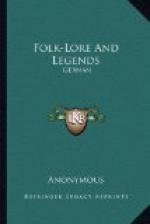As Thomas lay on Huntly Bank (a place on the descent of the Eildon Hills, which raise their triple crest above the celebrated monastery of Melrose), he saw a lady so extremely beautiful that he imagined she must be the Virgin Mary herself. Her appointments, however, were those rather of an amazon, or goddess of the woods. Her steed was of the highest beauty, and at its mane hung thirty silver bells and nine, which were music to the wind as she paced along. Her saddle was of “royal bone” (ivory), laid over with “orfeverie” (goldsmith’s work). Her stirrups, her dress, all corresponded with her extreme beauty and the magnificence of her array. The fair huntress had her bow in hand, and her arrows at her belt. She led three greyhounds in a leash, and three raches, or hounds of scent, followed her closely.
She rejected and disclaimed the homage which Thomas desired to pay her; so that, passing from one extremity to the other, Thomas became as bold as he had at first been humble. The lady warned him he must become her slave if he wished to prosecute his suit. Before their interview terminated, the appearance of the beautiful lady was changed into that of the most hideous hag in existence. A witch from the spital or almshouse would have been a goddess in comparison to the late beautiful huntress. Hideous as she was, Thomas felt that he had placed himself in the power of this hag, and when she bade him take leave of the sun, and of the leaf that grew on the tree, he felt himself under the necessity of obeying her. A cavern received them, in which, following his frightful guide, he for three days travelled in darkness, sometimes hearing the booming of a distant ocean, sometimes walking through rivers of blood, which crossed their subterranean path. At length they emerged into daylight, in a most beautiful orchard. Thomas, almost fainting for want of food, stretched out his hand towards the goodly fruit which hung around him, but was forbidden by his conductress, who informed him that these were the fatal apples which were the cause of the fall of man. He perceived also that his guide had no sooner entered this mysterious ground and breathed its magic air than she was revived in beauty, equipage, and splendour, as fair or fairer than he had first seen her on the mountain. She then proceeded to explain to him the character of the country.
“Yonder right-hand path,” she says, “conveys the spirits of the blest to paradise. Yon downward and well-worn way leads sinful souls to the place of everlasting punishment. The third road, by yonder dark brake, conducts to the milder place of pain, from which prayer and mass may release offenders. But see you yet a fourth road, sweeping along the plain to yonder splendid castle? Yonder is the road to Elfland, to which we are now bound. The lord of the castle is king of the country, and I am his queen; and when we enter yonder castle, you must observe strict silence, and answer no question that is asked you, and I will account for your silence by saying I took your speech when I brought you from middle earth.”




